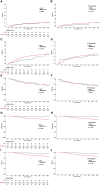Breast-conserving surgery versus mastectomy for treatment of breast cancer after neoadjuvant chemotherapy
- PMID: 37496664
- PMCID: PMC10368492
- DOI: 10.3389/fonc.2023.1178230
Breast-conserving surgery versus mastectomy for treatment of breast cancer after neoadjuvant chemotherapy
Abstract
Background: To compare recurrence and survival outcomes between breast-conserving surgery (BCS) and mastectomy after neoadjuvant chemotherapy (NACT).
Methods: The data of 730 patients who underwent NACT between 2000 and 2014 were retrospectively reviewed. A total of 104 (14.2%) patients received BCS and 626 (85.8%) received mastectomy. Locoregional recurrence (LRR), distant metastases (DM), disease-free survival (DFS), breast cancer-specific survival (BCSS), and overall survival (OS) were analyzed using the Kaplan-Meier method. The impact of BCS versus mastectomy on outcomes was assessed by multivariate Cox models. Inverse probability of treatment weighting (IPTW) was used to balance covariates between the two groups.
Results: The median follow-up of BCS and mastectomy groups were 86.5 and 87.4 months, respectively. There were significant differences in distribution of most baseline characteristics between two groups. Compared with those who underwent mastectomy, the patients with BCS had similar 5-year LRR, DM, and DFS rates, but had significantly higher 5-year BCSS (98.9% vs. 90.4%, P = 0.005) and OS (98.9% vs. 90.1%, P = 0.003) rates. Multivariate analysis also showed that BCS significantly improved BCSS (HR = 0.27, 95% CI: 0.08-0.85, P = 0.025) and OS (HR = 0.25, 95% CI: 0.08-0.79, P = 0.018). After IPTW adjustment, the LRR, DM, DFS, BCSS and OS between two groups had no significant differences.
Conclusions: The recurrence and survival outcomes are comparable with BCS and mastectomy. Thus, BCS is a safe treatment option for selected breast cancer patients after NACT.
Keywords: breast cancer; breast-conserving surgery; mastectomy; neoadjuvant chemotherapy; oncological outcomes.
Copyright © 2023 Song, Huang, Fang, Tang, Jing, Song, Jin, Liu, Chen, Tang, Qi, Lu, Li, Li and Wang.
Conflict of interest statement
The authors declare that the research was conducted in the absence of any commercial or financial relationships that could be construed as a potential conflict of interest.
Figures


Similar articles
-
Breast-conserving surgery is not associated with increased local recurrence in patients with early-stage node-negative triple-negative breast cancer treated with neoadjuvant chemotherapy.Breast. 2024 Apr;74:103701. doi: 10.1016/j.breast.2024.103701. Epub 2024 Feb 24. Breast. 2024. PMID: 38422624 Free PMC article.
-
Locoregional recurrence and survival of breast-conserving surgery compared to mastectomy following neoadjuvant chemotherapy in operable breast cancer.Front Oncol. 2024 Mar 28;14:1308343. doi: 10.3389/fonc.2024.1308343. eCollection 2024. Front Oncol. 2024. PMID: 38606101 Free PMC article.
-
Metastatic Pattern Discriminates Survival Benefit of Type of Surgery in Patients With De Novo Stage IV Breast Cancer Based on SEER Database.Front Surg. 2021 Nov 3;8:696628. doi: 10.3389/fsurg.2021.696628. eCollection 2021. Front Surg. 2021. PMID: 34805256 Free PMC article.
-
Outcomes after breast-conserving surgery or mastectomy in patients with triple-negative breast cancer: meta-analysis.Br J Surg. 2021 Jul 23;108(7):760-768. doi: 10.1093/bjs/znab145. Br J Surg. 2021. PMID: 34057990
-
Lympho-vascular invasion impacts the prognosis in breast-conserving surgery: a systematic review and meta-analysis.BMC Cancer. 2022 Jan 25;22(1):102. doi: 10.1186/s12885-022-09193-0. BMC Cancer. 2022. PMID: 35073848 Free PMC article.
Cited by
-
Oncological outcomes of breast-conserving surgery versus mastectomy following neoadjuvant chemotherapy in a contemporary multicenter cohort.Sci Rep. 2025 Mar 16;15(1):9032. doi: 10.1038/s41598-025-93491-7. Sci Rep. 2025. PMID: 40091103 Free PMC article.
-
Comparison of the effectiveness of neoadjuvant chemotherapy and adjuvant chemotherapy for improving prognosis in triple-negative breast cancer patients.Am J Transl Res. 2024 Aug 15;16(8):3978-3989. doi: 10.62347/VHME8736. eCollection 2024. Am J Transl Res. 2024. PMID: 39262758 Free PMC article.
-
Response-Adapted Oncologic Surgery in Cutaneous Squamous Cell Carcinoma: A Paradigm Shift Following Neoadjuvant Immunotherapy.Ann Surg Oncol. 2025 Aug 18. doi: 10.1245/s10434-025-18035-9. Online ahead of print. Ann Surg Oncol. 2025. PMID: 40824417
-
A Review of Breast Cancer Surgeries in a Sub-urban Nigerian Tertiary Hospital and the Limitations of Breast-Conserving Surgery.Breast Cancer (Auckl). 2025 Mar 12;19:11782234251323774. doi: 10.1177/11782234251323774. eCollection 2025. Breast Cancer (Auckl). 2025. PMID: 40078465 Free PMC article.
-
Survival Outcomes of Breast-Conserving Surgery Versus Mastectomy in Locally Advanced Breast Cancer Following Neoadjuvant Chemotherapy: A Meta-Analysis.Technol Cancer Res Treat. 2024 Jan-Dec;23:15330338241265030. doi: 10.1177/15330338241265030. Technol Cancer Res Treat. 2024. PMID: 39043051 Free PMC article.
References
-
- Fisher B, Anderson S, Bryant J, Margolese RG, Deutsch M, Fisher ER, et al. . Twenty-year follow-up of a randomized trial comparing total mastectomy, lumpectomy, and lumpectomy plus irradiation for the treatment of invasive breast cancer. N Engl J Med (2002) 347:1233–41. doi: 10.1056/NEJMoa022152 - DOI - PubMed
-
- Litière S, Werutsky G, Fentiman IS, Rutgers E, Christiaens MR, Van Limbergen E, et al. . Breast conserving therapy versus mastectomy for stage I-II breast cancer: 20 year follow-up of the EORTC 10801 phase 3 randomised trial. Lancet Oncol (2012) 13:412–9. doi: 10.1016/s1470-2045(12)70042-6 - DOI - PubMed
-
- Curran D, van Dongen JP, Aaronson NK, Kiebert G, Fentiman IS, Mignolet F, et al. . Quality of life of early-stage breast cancer patients treated with radical mastectomy or breast-conserving procedures: results of EORTC trial 10801. the European organization for research and treatment of cancer (EORTC), breast cancer Co-operative group (BCCG). Eur J Cancer (1998) 34:307–14. doi: 10.1016/s0959-8049(97)00312-2 - DOI - PubMed
LinkOut - more resources
Full Text Sources

